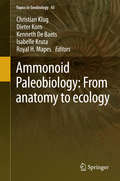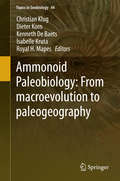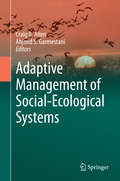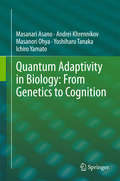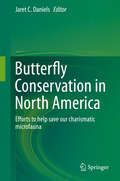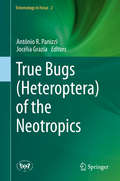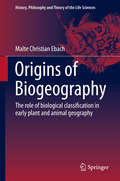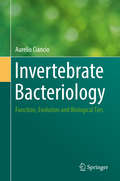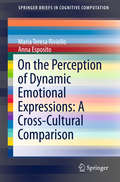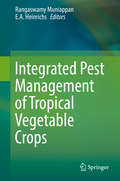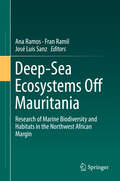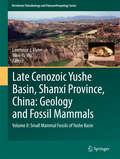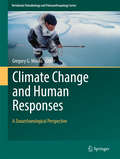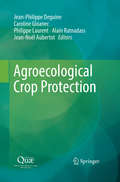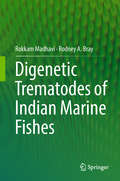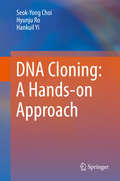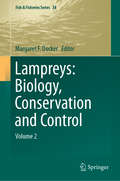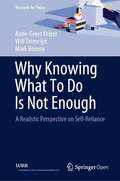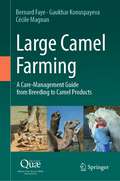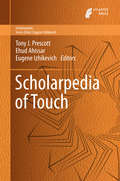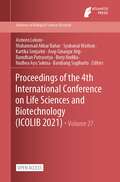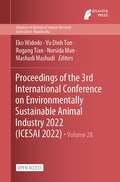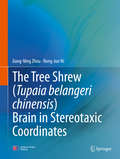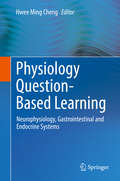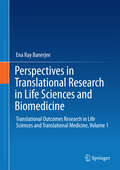- Table View
- List View
Ammonoid Paleobiology: From Anatomy To Ecology (Topics in Geobiology #43)
by Christian Klug Dieter Korn Kenneth De Baets Isabelle Kruta Royal H. MapesThis two-volume work is a testament to the abiding interest and human fascination with ammonites. We offer a new model to explain the morphogenesis of septa and the shell, we explore their habitats by the content of stable isotopes in their shells, we discuss the origin and later evolution of this important clade, and we deliver hypotheses on its demise. The Ammonoidea produced a great number of species that can be used in biostratigraphy and possibly, this is the macrofossil group, which has been used the most for that purpose. Nevertheless, many aspects of their anatomy, mode of life, development or paleobiogeographic distribution are still poorly known. Themes treated are biostratigraphy, paleoecology, paleoenvironment, paleobiogeography, evolution, phylogeny, and ontogeny. Advances such as an explosion of new information about ammonites, new technologies such as isotopic analysis, tomography and virtual paleontology in general, as well as continuous discovery of new fossil finds have given us the opportunity to present a comprehensive and timely "state of the art" compilation. Moreover, it also points the way for future studies to further enhance our understanding of this endlessly fascinating group of organisms.
Ammonoid Paleobiology: From Macroevolution To Paleogeography (Topics in Geobiology #44)
by Christian Klug Dieter Korn Kenneth De Baets Isabelle Kruta Royal H. MapesThis two-volume work is a testament to the abiding interest and human fascination with ammonites. We offer a new model to explain the morphogenesis of septa and the shell, we explore their habitats by the content of stable isotopes in their shells, we discuss the origin and later evolution of this important clade, and we deliver hypotheses on its demise. The Ammonoidea produced a great number of species that can be used in biostratigraphy and possibly, this is the macrofossil group, which has been used the most for that purpose. Nevertheless, many aspects of their anatomy, mode of life, development or paleobiogeographic distribution are still poorly known. Themes treated are biostratigraphy, paleoecology, paleoenvironment, paleobiogeography, evolution, phylogeny, and ontogeny. Advances such as an explosion of new information about ammonites, new technologies such as isotopic analysis, tomography and virtual paleontology in general, as well as continuous discovery of new fossil finds have given us the opportunity to present a comprehensive and timely "state of the art" compilation. Moreover, it also points the way for future studies to further enhance our understanding of this endlessly fascinating group of organisms.
Adaptive Management of Social-Ecological Systems
by Craig R. Allen Ahjond S. GarmestaniAdaptive management is an approach to managing social-ecological systems that fosters learning about the systems being managed and remains at the forefront of environmental management nearly 40 years after its original conception. Adaptive management persists because it allows action despite uncertainty, and uncertainty is reduced when learning occurs during the management process. Often termed “learning by doing”, the allure of this management approach has entrenched the concept widely in agency direction and statutory mandates across the globe. This exceptional volume is a collection of essays on the past, present and future of adaptive management written by prominent authors with long experience in developing, implementing, and assessing adaptive management. Moving forward, the book provides policymakers, managers and scientists a powerful tool for managing for resilience in the face of uncertainty.
Quantum Adaptivity in Biology: From Genetics to Cognition
by Masanari Asano Andrei Khrennikov Masanori Ohya Yoshiharu Tanaka Ichiro YamatoThis book examines information processing performed by bio-systems at all scales: from genomes, cells and proteins to cognitive and even social systems. It introduces a theoretical/conceptual principle based on quantum information and non-Kolmogorov probability theory to explain information processing phenomena in biology as a whole.The book begins with an introduction followed by two chapters devoted to fundamentals, one covering classical and quantum probability, which also contains a brief introduction to quantum formalism, and another on an information approach to molecular biology, genetics and epigenetics. It then goes on to examine adaptive dynamics, including applications to biology, and non-Kolmogorov probability theory.Next, the book discusses the possibility to apply the quantum formalism to model biological evolution, especially at the cellular level: genetic and epigenetic evolutions. It also presents a model of the epigenetic cellular evolution based on the mathematical formalism of open quantum systems. The last two chapters of the book explore foundational problems of quantum mechanics and demonstrate the power of usage of positive operator valued measures (POVMs) in biological science.This book will appeal to a diverse group of readers including experts in biology, cognitive science, decision making, sociology, psychology, and physics; mathematicians working on problems of quantum probability and information and researchers in quantum foundations.
Butterfly Conservation in North America: Efforts to help save our charismatic microfauna
by Jaret C. DanielsThe book addresses this critical need by providing a straightforward and easy to read primer to key elements of at-risk butterfly conservation programs including captive husbandry, organism reintroduction, habitat restoration, population monitoring, recovery planning and cooperative programs.Impacts from habitat loss and fragmentation, invasive species, and climate change continue to accelerate the rate of imperilment and necessitate increased conservation action.Zoos, natural history museums, botanical gardens and wildlife agencies are progressively focusing on insects, particularly charismatic groups such as butterflies and native pollinators, to help advance local conservation efforts and foster increased community interest and engagement.Today, many institutions and their partners have successfully initiated at-risk butterfly conservation programs, and numerous others are exploring ways to become involved. However, insufficient experience and familiarity with insects is a critical constraint preventing staff and institutions from adequately planning, implementing and evaluating organism-targeted activities.The information provided is intended to improve staff practices, learn from existing programs, promote broader information exchange, and strengthen institutional ability to develop new or improve existing butterfly conservation initiatives.The information provided is intended to improve staff practices, learn from existing programs, promote broader information exchange, and strengthen institutional ability to develop new or improve existing butterfly conservation initiatives.This book will be useful to professionals from zoos, natural history museums, botanical gardens, wildlife agencies, conservation organizations, land managers, students, and scientist in conservation biology, ecology, entomology, biology, and zoology.
True Bugs (Entomology in Focus #2)
by Antônio R. Panizzi Jocélia GraziaTrue bugs (Heteroptera) are a diverse and complex group of plant-feeding and predatory insects important to food production, human health, the global economy and the environment. Within the nearly 43,000 species described around the world, Neotropical true bugs are particularly diverse, and much remains to be discovered about their biology and relations with other species. Inspired by the need for a comprehensive assessment, True Bugs (Heteroptera) of the Neotropics is the most complete and thorough review ever published.Experts in each of the seven infraorders have drawn together the scattered literature to provide detailed treatments of each major taxon. The most common and important species as well as select lesser known species in each major family are covered, highlighting morphology, classification, biology and ecology. The numerous color illustrations highlight key species and their adaptations, and importance to basic and applied sciences is discussed.Each chapter is based on an up-to-date review of the literature, and with a bibliography of more than 3,000 references, readers are presented with an unprecedented and vital and timely account of the true bugs of the Neotropical Region.
Origins of Biogeography: The role of biological classification in early plant and animal geography (History, Philosophy and Theory of the Life Sciences #13)
by Malte Christian EbachThis book presents a revised history of early biogeography and investigates the split in taxonomic practice, between the classification of taxa and the classification of vegetation. It moves beyond the traditional belief that biogeography is born from a synthesis of Darwin and Wallace and focuses on the important pioneering work of earlier practitioners such as Zimmermann, Stromeyer, de Candolle and Humboldt.Tracing the academic history of biogeography over the decades and centuries, this book recounts the early schisms in phyto and zoogeography, the shedding of its bonds to taxonomy, its adoption of an ecological framework and its beginnings at the dawn of the 20th century. This book assesses the contributions of key figures such as Zimmermann, Humboldt and Wallace and reminds us of the forgotten influence of plant and animal geographers including Stromeyer, Prichard and de Candolle, whose early attempts at classifying animal and plant geography would inform later progress.The Origins of Biogeography is a science historiography aimed at biogeographers, who have little access to a detailed history of the practices of early plant and animal geographers. This book will also reveal how biological classification has shaped 18th and 19th century plant and animal geography and why it is relevant to the 21st bio geographer.
Invertebrate Bacteriology: Function, Evolution and Biological Ties (Sustainability In Plant And Crop Protection Ser.)
by Aurelio CiancioThis compendium reviews different processes acting on bacterial groups that evolved one or more relationships with members of the most important invertebrate Phyla. Starting from principles of basic bacteriology the book provides data on bacteria interactions with pests, animal or human diseases. Being present in all environments, from deep see to crops, animals or plants, invertebrates represent the most significant and ancient fraction of the eukaryotic biomass on earth. Their evolutive adaptations and links with bacteria, established over time scales of ages, range from vectored diseases to speciation, within a wide range of environmental niches and biocenosis, including oceanic hydrothermal vents. Main functional processes include pathogenicity, parasitism, transmission, immunity, symbiosis and speciation. A review about recent advances achieved in these research topics is given, focussing on one or more aspects concerning significant evolutive paths of bacteria and underlying functional links. Rather than proceeding through the order and structure of taxonomies, the volume is organized by processes, examining their functional role in different lineages, including but not limited to insects or nematodes. Processes involved in parasitism focus, at a finer level, on examples from many taxa. Molecular aspects underpinning these and other functional processes include the effects of horizontal gene transfer, the mechanisms active in immune defense and vectoring, and the antibacterial peptides. Finally, the effects of climate warming, biological invasions and agriculture are examined, with particular attention to farming and environment.
On the Perception of Dynamic Emotional Expressions: A Cross-cultural Comparison (SpringerBriefs in Cognitive Computation #6)
by Maria Teresa Riviello Anna EspositoThis work explores the power of visual and vocal channels, in conveying emotional cues exploiting realistic, dynamic and mutually related emotional vocal and facial stimuli, and aims to report on a cross cultural comparison on how people from different Western Countries perceive emotional dynamic stimuli. The authors attempt to give an answer to the following questions evaluating the subjective perception of emotional states in the single (either visual or auditory channel) and the combined channels:- In a body-to-body interaction, the addressee exploits both the verbal and non-verbal communication modes to infer the speaker’s emotional state. Is such an informational content redundant? - Is the amount of information conveyed by each communication mode the same or is it different? - How much information about the speaker’s emotional state is conveyed by each mode and is there a preferential communication mode for a given emotional state? -To what extent the cultural specificity affect the decoding of the emotional information? The results are interpreted in terms of cognitive load, language expertise and stimulus dynamics. This book will be of interest to researchers and scholars in the field of Human Computer Interaction, Affective Computing, Psychology, Social Sciences .
Integrated Pest Management of Tropical Vegetable Crops
by Rangaswamy Muniappan E. A. HeinrichsIt is an edited book with chapters written by multi-disciplinary specialists in their specific subject areas. It covers development of IPM components and packaging them for individual vegetable crops specifically targeted to tropical countries. Scientific background for IPM components or tactics will be included. There will be case studies of IPM packages developed and implemented in different countries. The concept of IPM has been in existence for the past six decades; however, a practical holistic program has not been developed and implemented for vegetable crops, in the developing countries. Currently the IPM adoption rate in the tropics is minimal and there is a need for implementation of IPM technologies that are environmentally safe, economical, and socially acceptable. We believe that adoption and implementation of IPM provided in this book will lead to significant reduction in crop losses and mitigate adverse impacts of pesticide use in the tropics. This book is an outcome 20 years of research, development and implementation of the IPM CRSP, a project supported by USAID and administered by Virginia Tech in several developing countries along the tropical belt in Africa, Asia, Latin America and the Caribbean.
Deep-Sea Ecosystems Off Mauritania: Research of Marine Biodiversity and Habitats in the Northwest African Margin
by Ana Ramos Fran Ramil José Luis SanzThis book compiles the main findings of the multidisciplinary long-term research program developed in the continental margin of one of the more productive and unknown areas of the world oceans, Northwest Africa. The more than 25,000 preserved fishes and benthic invertebrates and quantitative data collected in 342 trawling stations, the 267 oceanographic profiles, the 211 sediment samples and the 28,122 km2 prospected by multi˗beam echo sounding allowed to obtain an overview of the amazing biodiversity of the demersal and benthic fauna inhabiting soft- and hard-bottom habitats, as well as the fascinating geomorphology and oceanography, hidden in the Mauritanian slope.
Late Cenozoic Yushe Basin, Shanxi Province, China: Volume II: Small Mammal Fossils of Yushe Basin (Vertebrate Paleobiology and Paleoanthropology)
by Lawrence J. Flynn Wen-Yu WuThis volume focuses on small mammal fossils from extinct Asian faunas of about 1 to 7 million years ago in North China. These played a role in the emergence of vertebrate paleontology as a modern science in that country. This second volume of the sub-series Late Cenozoic Yushe Basin, Shanxi Province, China: Geology and Fossil Mammals in the Vertebrate Paleobiology and Paleoanthropology book series deals with a rich microfauna fossil record; megafauna follow in subsequent volumes. This research on Yushe Basin fossils provides a view of changes in northeast Asian terrestrial faunas during the Late Neogene, and therefore is a key to the biochronology for a vast part of the continent. The faunas recovered by the multinational team working in this region represent changes in small mammal communities of the Yushe Basin, revealed on a finer time scale that has not been achieved previously. Detailed systematic studies on small mammal groups proceeded under the care of specialists are outlined in the chapters of this volume. Paleontologists, ecologists and evolutionary biologists will find this book appealing.
Climate Change and Human Responses: A Zooarchaeological Perspective (Vertebrate Paleobiology and Paleoanthropology)
by Gregory MonksThis book contributes to the current discussion on climate change by presenting selected studies on the ways in which past human groups responded to climatic and environmental change. In particular, the chapters show how these responses are seen in the animal remains that people left behind in their occupation sites. Many of these bones represent food remains, so the environments in which these animals lived can be identified and human use of those environments can be understood. In the case of climatic change resulting in environmental change, these animal remains can indicate that a change has occurred, in climate, environment and human adaptation, and can also indicate the specific details of those changes.
Agroecological Crop Protection
by Jean-Philippe Deguine Caroline Gloanec Philippe Laurent Alain Ratnadass Jean-Noël AubertotThis book is devoted to Agroecological Crop Protection, which is the declension of the principles of agroecology to crop protection. It presents the concepts of this innovative approach, case studies and lessons and generic keys for agroecological transition. The book is intended for a wide audience, including scientists, experimenters, teachers, farmers, students. It represents a new tool, proposing concrete keys of action on the basis of feedbacks validated scientifically. Beyond the examples presented, it is therefore of general scope and proposes recommendations for all temperate and tropical cropping systems. It contributes to the training and teaching modules in this field and it is an updated information support for professionals and a teaching aid for students (agronomy, crop protection, biodiversity management, agroecology).
Digenetic Trematodes of Indian Marine Fishes
by Rokkam Madhavi Rodney A. BrayThis book is the first to explore in detail the systematics and taxonomy of the digenean fauna of fish in Indian marine waters. It includes morphological descriptions of 648 species in 190 genera and 30 families. The figures from the original publications are enhanced and made more attractive. Each description is accompanied by information on hosts and distribution. Digenetic trematodes, usually known as Digeneans, are the most diverse group of metazoan parasites of marine fishes. They are parasitic flatworms (Phylum Platyhelminthes) with a complex life-cycle and as adults inhabit mainly the alimentary system and associated organs, but also occur in the blood, under the scales, in the body cavity and in the gall and urinary bladders. Keys to families, genera and species are provided, except for a few large and controversial genera, where morphological characters are insufficient for identification. Although there is extensive literature on Digeneans, it is scattered and largely in obscure local journals. Bringing together most of the primary literature on the subject, this book provides a primer for further study and a starting point for the use of modern molecular methods for the fauna of this region. Unique in its scope, it is a valuable resource for students, professional parasitologists and ecologists as well as fishery and wildlife biologists.
DNA Cloning: A Hands-on Approach
by Seok-Yong Choi Hyunju Ro Hankuil YiThis book offers step-by-step instruction on DNA cloning, defined as moving genes around plasmids, mutating genes, or mining new genes. The aim is to provide those new to the field with reliable and up-to-date practical guidance while at the same time conveying the scope for creativity. After a brief synopsis of the history of cloning, the fundamentals and prerequisites are explained, covering, for example, software, vectors commonly used in the lab, appropriate choice of restriction endonucleases, the preparation of agarose gels, competent cells, and LB agar plates, and procedures to be followed upon receipt of new plasmids. The remainder of the book is devoted to the clear description of methods and individual steps in cloning. Guidance is provided on the cut and paste method, DNA sequencing, direct sequencing, primer design, PCR-based gene insertion and deletion, epitope tag insertion, the use of RACE technology, BAC recombineering, and much, much more. Sources of error and a variety of techniques that make life considerably easier when cloning are also examined in detail.
Lampreys: Volume 2 (Fish & Fisheries Series #38)
by Margaret F. DockerThis book, published in two volumes, provides the most comprehensive review of lamprey biology since Hardisty and Potter’s “The Biology of Lampreys” published more than 30 years ago. This second volume offers a synthesis of topics related to the lamprey gonad (e.g., lamprey sex ratios, sex determination and sex differentiation, sexual maturation, and sex steroids), the artifical propagation of lampreys, post-metamorphic feeding and the evolution of alternative feeding and migratory types, the history and status of sea lamprey control in the Laurentian Great Lakes and Lake Champlain, and an overview of contributions of lamprey developmental studies for understanding vertebrate evolution.
Why Knowing What To Do Is Not Enough: A Realistic Perspective on Self-Reliance (Research for Policy)
by Anne-Greet Keizer Will Tiemeijer Mark BovensThis open access book sets out to explain the reasons for the gap between “knowing” and “doing” in view of self-reliance, which is more and more often expected of citizens. In today’s society, people are expected to take responsibility for their own lives and be self-reliant. This is no easy feat. They must be on constant high alert in areas of life such as health, work and personal finances and, if things threaten to go awry, take appropriate action without further ado. What does this mean for public policy? Policymakers tend to assume that the government only needs to provide people with clear information and that, once properly informed, they will automatically do the right thing. However, it is becoming increasingly obvious that things do not work like that. Even though people know perfectly well what they ought to do, they often behave differently. Why is this? This book sets out to explain the reasons for the gap between ‘knowing’ and ‘doing’. It focuses on the role of non-cognitive capacities, such as setting goals, taking action, persevering and coping with setbacks, and shows how these capacities are undermined by adverse circumstances. By taking the latest psychological insights fully into account, this book presents a more realist perspective on self-reliance, and shows government officials how to design rules and institutions that allow for the natural limitations in people’s ‘capacity to act’.
Large Camel Farming: A Care-Management Guide from Breeding to Camel Products
by Bernard Faye Gaukhar Konuspayeva Cécile MagnanThis practical guide is intended for all actors in the sector who work with large camelids, whether in breeding, technical advice or veterinary care. It successively describes the general aspects of the species, the physiological bases of reproduction, lactation and feeding, the main production processes, and health and hygiene management in camel breeding. Chapters on slaughter, important camel products and their processing complete the volume.Large camels (camels and Bactrian camels) are domestic animals that are increasingly used in Western countries, as well as in Africa and Asia, for tourism, sport, and production of milk, meat, and wool. In addition, camel husbandry systems are changing, taking a greater share of sedentary systems, specializing in breeding, and intensifying production. At the same time, many veterinarians and breeders are not familiar with the animal, its needs, physiology, diseases, and management, which is often based on practices introduced for cattle and proving ineffective.This work is a practical aid for all interested readers who want to embark on the adventure of working with large camelids in a cultural context where they are not yet a dominant element of the agricultural landscape. The numerous photographs and drawings that support the text make it a unique and entertaining read.
Scholarpedia of Touch (Scholarpedia)
by Tony J. Prescott Ehud Ahissar Eugene IzhikevichScholarpedia’s Encyclopedia of Touch provides a comprehensive collection of peer-reviewed articles written by leading researchers, detailing our current scientific understanding of tactile sensing and its neural substrates in animals including humans. The encyclopedia allows ideas and insights to be shared between researchers working on different aspects of touch and in different species, including research in synthetic touch systems. In addition, this encyclopedia raises awareness of research in tactile sensing and increases scientific and public interest in the field.The articles address subjects including tactile control, whiskered robots, vibrissal coding, the molecular basis of touch, invertebrate mechanoreception, fingertip transducers and tactile sensing.All the articles in this encyclopedia provide in-depth and state-of-the-art scholarly treatment of the academic topics concerned, making it an excellent reference work for academics, professionals and students.
Proceedings of the 4th International Conference on Life Sciences and Biotechnology (Advances in Biological Sciences Research #27)
by Bambang SugihartoThis is an open access book.We are pleased to invite you to participate in the 4th International Confrerence on Life Sciences and Biotechnology, “Towards Sustainable Development: Application of Biosciences to Improve Welfare and Quality of Life“. The International Conference which will be held on by The Department of Biology, Faculty of Mathematics and Natural Sciences, University of Jember November 15-16, 2021.The 1st, 2nd, and 3rd ICOLIB had been successfully held in 2015, 2017, and 2019 in University of Jember, respectively. This year’s conference will be held virtually, and present some outstanding speakers coming from Indonesia, Germany, Nederland, The United States of America and South Korea.
Proceedings of the 3rd International Conference on Environmentally Sustainable Animal Industry 2022 (Advances in Biological Sciences Research #28)
by Eko Widodo Vu Dinh Ton Rugang Tian Norsida Man Mashudi MashudiThis is an open access book.The 3rd ICESAI aims to discuss issues related to the development of an eco-friendly and sustainable livestock industry using smart farming which is related to scientific research and how it is applied. The 3rd ICESAI offers opportunities for the for researchers and the livestock industry from all over the world to share experiences, learn and expand networking on several matters relating to the development of a sustainable and environmentally friendly livestock industry, especially with the implementation of smart farming.
The Tree Shrew (Tupaia belangeri chinensis) Brain in Stereotaxic Coordinates
by Jiang-Ning Zhou Rong-Jun NiThis atlas is currently the most systematic and comprehensive atlas of the tree shrew brain. The purpose of this book is to help scientists acquire accurate coordinates of the brain regions of the tree shrew, which is becoming a popular animal model for a variety of human diseases. This atlas contains series of 192 coronal sections, 36 sagittal sections, and 49 horizontal sections using Nissl staining or acetylcholinesterase histochemistry as well as a series of diagrams in stereotaxic coordinates. Original photomicrographs are obtained at single-cell resolution. In addition, we also referred to magnetic resonance images acquired at 250 um intervals with a magnetic resonance scanner 9.4T. Many brain structures are first identified in tree shrews and accurately presented in a stereotaxic coordinate system. The Bregma coordinates system is used for the first time in this tree shrew brain atlas. The atlas represents the collaboration between two indispensable skills of brain research, neuroanatomy and stereotaxic surgery. It will be extensively used in neuroscience research, particularly tree shrew brain study, and will help graduate students and researchers understand brain anatomy and acquire accurate reference coordinates.
Physiology Question-Based Learning: Neurophysiology, Gastrointestinal and Endocrine Systems
by Hwee Ming ChengThis book provides the reader with a range of questions and explanations related to essential aspects of the neural, hormonal and gastrointestinal physiology. The focus of the book is on understanding the homeostatic control in each system by using questions to challenge the reader to think through physiology. In addition, functional integration of the different organ systems is highlighted in an area such as neuroendocrinology and in the study of the neural mechanisms in the gastrointestinal tract. This is the second Physiology Question-Based Learning book, written by Prof. Dr. Cheng. He has taught physiology for thirty years. He has pioneered the international physiology quiz, which is now an annual event at the University of Malaya in Kuala Lumpur, Malaysia and at universities around the world. As quiz master, he has designed challenging questions to test concepts and understanding in physiology. This book reflects the style of questions asked during the physiology quiz. The questions are designed to stimulate integrative and homeostatic thinking in physiology. The Physiology Question-Based Learning books will be helpful to all students of Physiology in medicine, dentistry, pharmacy and allied health sciences. This work is written to make physiology learning engaging and enjoyable and to encourage effective teaching in physiology.
Perspectives in Translational Research in Life Sciences and Biomedicine: Translational Outcomes Research in Life Sciences and Translational Medicine, Volume 1
by Ena Ray BanerjeeThe present book addresses the multi-disciplinary nature of Translational Outcomes Research, which is a watershed for nearly all the disciplines of Life and Health Sciences, along with the Materials Sciences including but not limited to Zoology, Botany, Microbiology, Biochemistry, Physiology, Nanotechnology, the Medical Sciences, Bioengineering, Biophysics, Medicinal Chemistry, Structural Biology, Biostatistics and Bioinformatics. This book, for the first time, addresses the basic premises of fundamental research in facilitating drug discovery. One chapter is dedicated to a novel generation of platforms with novel camelid antibodies and their technological extensions, while another focuses on functional food and nutraceuticals. The book begins with a thorough overview of what translational outcomes research connotes and what the current status of research in the area is, and goes on to elucidate various pertinent preclinical disease models and their uses in basic and application based research in the Life Sciences. How basic approaches to screening and characterization vis-à-vis their role in amelioration of the two cardinal problems of inflammation and degeneration involved in most diseases is elucidated. The book ends with a discussion of the relevance and importance of using Bio Green technology in Translational Outcomes, addressing the need to fill the gap between academia and industry and clinics that can arise through direct or indirect collaboration between the stakeholders and emphasizing the need for an eco-friendly approach so as not to jeopardize the fine balance that holds life on earth in harmony.
